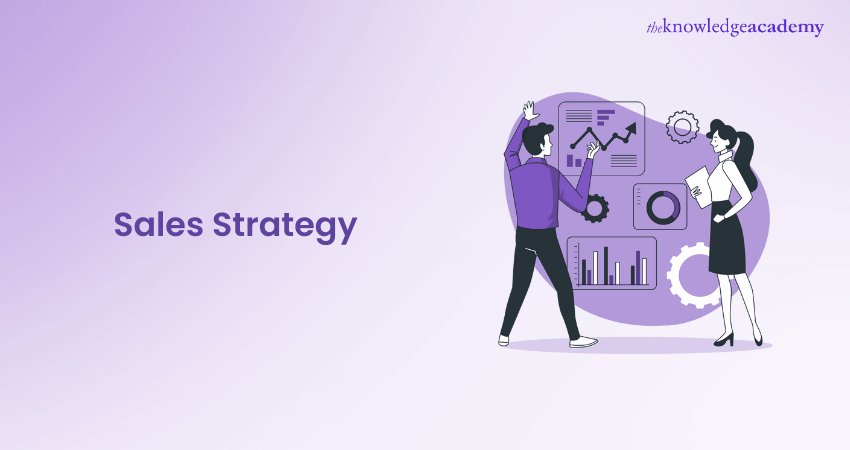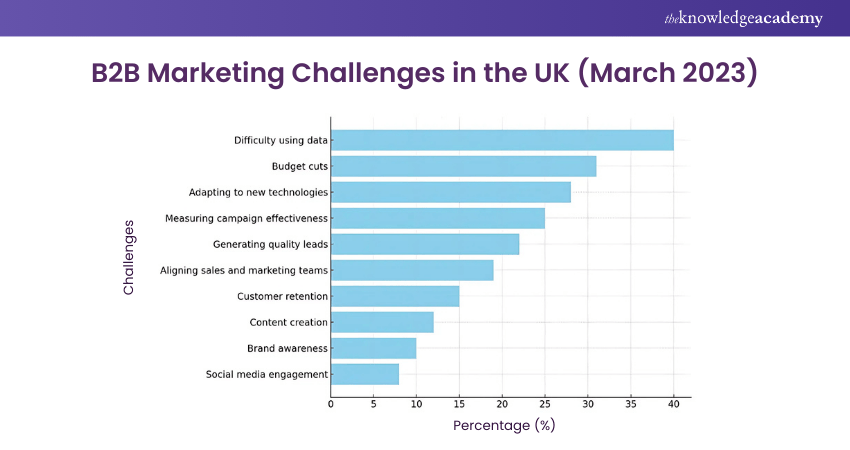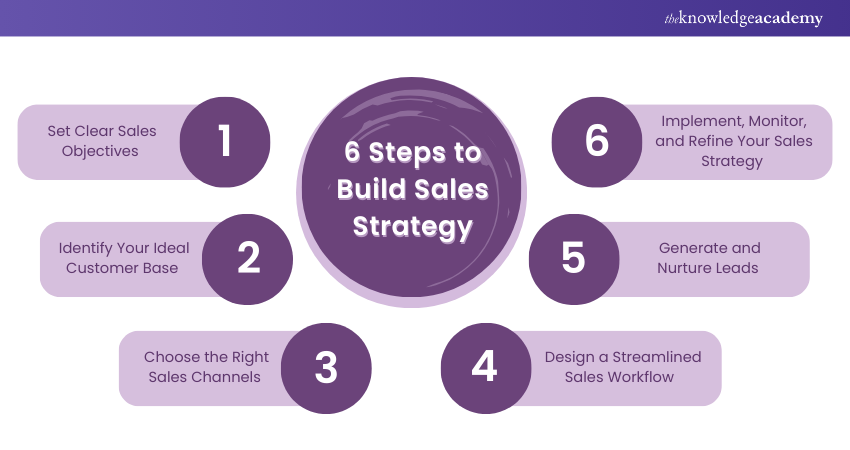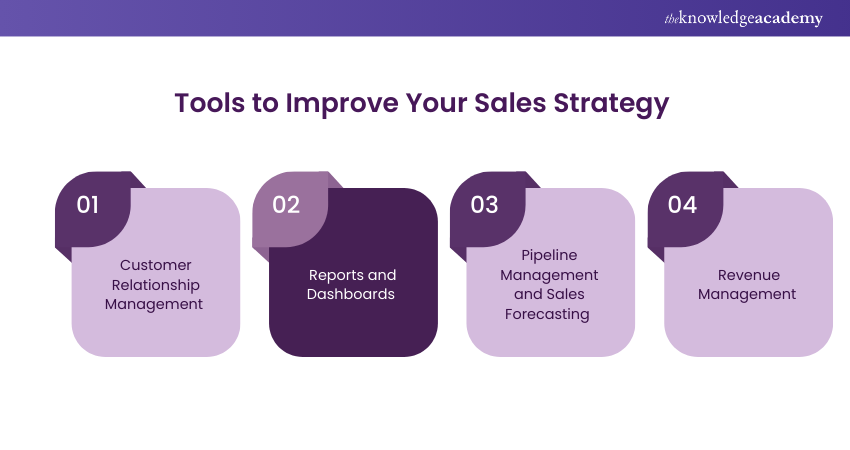We may not have the course you’re looking for. If you enquire or give us a call on 01344 203999 and speak to our training experts, we may still be able to help with your training requirements.
We ensure quality, budget-alignment, and timely delivery by our expert instructors.

Imagine this scenario: you have a promising pipeline, a strong product, and motivated prospects, yet your sales numbers aren’t where you want them to be. What is missing? A focused and efficient Sales Strategy is the answer—and it is easier to implement than you think.
In this blog, we’ll break down 10 practical steps to help you create a Sales Strategy that works smarter, not harder. From identifying the right opportunities to streamlining your process, these tips will set you on the path to more effective selling.
Table of Contents
1) What is a Sales Strategy?
2) 10 Popular Sales Strategy Types
3) Why is a Sales Strategy Important?
4) How to Build a Sales Strategy in 6 Steps?
5) Tools to Improve Your Sales Strategy
6) Sales Strategy Example
7) What is the 3-3-3 Rule in Sales?
8) What is the Golden Rule of Sales?
9) Conclusion
What is a Sales Strategy?
A Sales Strategy is a carefully designed plan that outlines how a business will sell its products or services to customers. It includes identifying target markets, setting sales management goals, choosing the right selling methods, and using tools to track and improve performance.
A strong Sales Strategy helps your team focus on the right opportunities and approach customers effectively. In B2B Marketing, this ultimately serves as a roadmap for achieving consistent sales success and business growth.
10 Popular Sales Strategy Types
Here are 10 popular Sales Strategies that businesses use to effectively reach and engage their customers. Each strategy offers a unique approach to selling, tailored to different types of customers and market situations.
Inbound vs Outbound
Broadly speaking, Sales Strategies can be categorised as either inbound or outbound, based on who initiates the sales relationship. If the prospect contacts the business first, this is considered inbound selling; if the sales representative reaches out to the prospective customer, this is outbound selling.
Examples of inbound sales strategies include:
a) Content Marketing
b) Search Engine Optimisation (SEO)
c) Social Media Channels
d) Email Marketing (can be both inbound and outbound)
Examples of outbound marketing include:
a) Cold Calls
b) Cold Emailing
c) Telemarketing
d) Print Advertising
e) Pay-per-click Ads
In addition to the categories of inbound and outbound selling, teams can employ various selling methods as part of their broader strategy. These include:
1) Direct Selling
Direct selling involves reaching out to customers personally to sell a product or service. Salespeople engage with potential customers face-to-face, over the phone, or through online communication. The aim is to develop relationships and trust while directly promoting what you're offering. This strategy is often used in industries like retail, cosmetics, and real estate.
Gain the knowledge and techniques to close more deals - join our Sales Negotiation Training today!
2) Partner Selling
Partner selling involves collaborating with another company to sell your product or service. These partners could be distributors, resellers, or other businesses that complement your offering. The goal is to leverage the partner's customer base and expertise to reach new markets. It's a mutually beneficial arrangement that expands sales opportunities.
3) Account-based Selling
Account-based selling focuses on targeting specific high-value customers or accounts. Sales teams create personalised strategies for each account, understanding their needs and challenges. The approach is tailored to build strong relationships with key decision-makers. It's often used in B2B sales, where the value of each deal is high.

4) Consultative Selling
Consultative selling is about understanding the customer's needs and providing expert advice to solve their problems. Salespeople act more like advisors, offering solutions that best fit the customer's situation. This strategy involves asking questions, listening carefully, and providing tailored recommendations. The focus is on building trust and long-term relationships.
5) SPIN Selling
SPIN selling is a technique where salespeople ask four types of questions: Situation, Problem, Implication, and Need-payoff. These questions help uncover the customer's needs and demonstrate the value of your product. The goal is to guide the customer to realise that your solution is the best fit. It's a structured approach often used in complex sales.
8) Value-based Selling
Value-based selling emphasises the value and benefits that your product or service brings to the customer. Instead of just focusing on features, you highlight how they solve the customer's problems or improve their situation. The aim is to align your offering with the customer's priorities and demonstrate a clear return on investment. This approach is effective in both Business-to-business (B2B) and Business-to-consumer (B2C) sales.
7) Solution Selling
Solution selling involves identifying the customer's specific problems and offering a tailored solution. Rather than selling a product as it is, the focus is on how it can be adapted or bundled to meet the customer's needs. The strategy is consultative and often requires a deep understanding of the customer's business. It's common in industries like IT and professional services.
8) Challenger Selling
Challenger selling is about teaching, tailoring, and taking control of the sales conversation. Salespeople challenge the customer's assumptions and provide insights that lead them to rethink their approach. The goal is to push the customer out of their comfort zone and guide them to a better solution. This approach works well in complex sales where the customer may need a new perspective.
Learn how to sell value in challenging times with our Value Based Selling Training – Join today!
9) Conceptual Selling
Conceptual selling is a sales approach based on the premise that prospects purchase for unique reasons, often differing from what the seller assumes. This technique is particularly useful while dealing with large corporations involving high-value, complex deals with multiple decision-makers.
Using this technique, salespeople must invest time in understanding the prospect and their concept of what they need. This involves thorough research of the customer to uncover any underlying perceptions and motivations behind a potential purchase, a topic often explored in Sales Interview Questions.
Conceptual selling is a holistic approach that focuses on how the product or service aligns with the prospect's long-term objectives. It emphasises collaboration and the cultivation of long-term relationships, demonstrating how NLP is useful in successful selling by enhancing communication, understanding customer needs, and building stronger connections.
10) SNAP Selling
SNAP selling is founded on the principle that customers are inundated with information, distractions, and numerous responsibilities, necessitating a fast, simple, and effective selling method. SNAP represents the four core principles of this approach:
a) Simple: Salespeople should present their solutions in a straightforward and easy-to-understand manner.
b) Invaluable: They should position their products as indispensable to the prospect and themselves as trusted partners in the sales process.
c) Aligned: They should ensure that their sales message aligns with the buyers' objectives, needs, and core beliefs.
d) Priority: They should address the issues of highest priority to the buyer and position their product as the best solution to the needs they care about most.
Why is a Sales Strategy Important?
A well-crafted Sales Strategy acts as a blueprint for your business's growth. It is essential for future planning, problem-solving, goal setting, and management. Let’s explore its importance:
a) Provide Direction and Focus: Clear strategic guidance helps your sales team understand which goals and activities to prioritise, leading to enhanced productivity and results.
b) Ensure Consistent Messaging: A unified Sales Strategy enables your team to deliver a consistent message to prospects, partners, and customers, thereby building trust and increasing effectiveness.
c) Optimise Opportunities: A strong Sales Strategy allows you to target the right prospects and tailor your approach, ensuring your team capitalises on every sales opportunity.
d) Improve Resource Allocation: By defining your priorities and resources, your sales strategy helps your team use their time, effort, and other resources more efficiently, enhancing their ability to focus on high-potential deals.
How to Build a Sales Strategy in Six Steps?
To build a successful Sales Strategy, it's important to follow a clear and structured approach. These six steps will guide you in setting objectives, understanding your customers, and creating an efficient process to drive consistent sales growth.

1) Set Clear Sales Objectives
Begin by identifying precisely what you want your income group to acquire. These dreams will comprise a variety of income, revenue targets, or expanding into new markets. Make sure your targets are unique and measurable so that everyone is aware of what fulfillment seems like.
Clear desires help your mind stay focused and influenced. Regularly assess and regulate these goals to hold your method on track.
2) Identify Your Ideal Customer Base
Take the time to apprehend who your satisfactory customers are and what they want. You can categorise them by using size, in which one technique aims massive groups for high-value offers, and some other specialises in small to medium agencies for higher-extent, and reduced-price offers.
The area is also essential, mainly if your business is expanding globally; this permits you to tailor your approach to local desires, languages, and cultural nuances. By specialising in industry, you can organise customers by means of sectors like production, healthcare, or financial offerings, allowing your team to develop knowledge and address unique ache areas.
Lastly, consider Product categories, particularly if your company offers both legacy and new products; dedicating specific sales teams to each can ensure success across all offerings.
3) Choose the Right Sales Channels
Decide how you will reach your customers, whether it’s online, in-person, over the phone, or through other methods. Different customers prefer different ways of buying, so it's important to choose the channels that work best for your audience. Make sure your sales team is comfortable and effective in these channels.
Using the right platforms will make it easier to connect with your customers. This ensures you are meeting them where they are most likely to engage.
4) Design a Streamlined Sales Workflow
Create a step-by-step process that your sales team can follow to close deals effectively. This process should include everything from the first contact with a customer to finalising the sale. A well-organised workflow helps your team work more efficiently and reduces the chances of missing important steps.
Make sure everyone on+ the team understands and follows this process. A smooth workflow leads to better results and happier customers.
5) Generate and Nurture Leads
Work on filling your income pipeline with potential clients who might be inquisitive about your service or product. Use advertising campaigns, referrals, and other strategies to draw those leads. Once you have leads, nurture them by retaining in contact and presenting treasured information.
This keeps your business on track and will increase the possibilities of making a purchase. Consistently including and nurturing leads ensures a steady glide of capability income.
6) Implement, Monitor, and Refine Your Sales Strategy
Put your sales plan into action and start working towards your goals. Keep an eye on how well your strategy is performing by tracking key metrics like sales numbers and customer feedback. If something isn’t working as expected, be ready to make changes and try new approaches.
Regular monitoring helps you detect problems early and improve your strategy over time. Adjusting your plan as you go ensures you stay on the path to success.
Learn how to improve your Outbound Sales performance with our Outbound Sales Training – Join today!
Tools to Improve Your Sales Strategy
Here are some of the tools to enhance your strategy:

1) Customer Relationship Management
Customer Relationship Management (CRM) gear assists you keep a record of all of your purchaser interactions in one place. They store important data like contact information, purchase history, and conversation logs. This makes it easier for your sales team to manipulate relationships and observe up effectively.
A right CRM System can improve customer satisfaction and raise sales through ensuring no opportunities are neglected.
2) Reports and Dashboards
Reports and dashboards provide a clear overview of your sales performance by showing key metrics like sales volume, revenue, and conversion rates. They help you quickly identify trends, spot potential issues, and track progress toward your goals.
With this information, you can make informed decisions to improve your Sales Strategy. Regularly reviewing these insights ensures your team stays on track and focuses on what matters most.
3) Pipeline Management and Sales Forecasting
Pipeline management tools help you monitor where each potential sale is in the process, from initial contact to closing the deal. Sales forecasting uses this data to predict future sales, helping you plan resources and set realistic targets.
Together, these Types of Sales Tools give you a clear picture of your sales flow and potential outcomes. This helps you make adjustments to meet your goals and ensure consistent revenue.
4) Revenue Management
Revenue management tools help you track and optimise the money coming into your business. They allow you to analyse pricing, sales patterns, and profitability to make better financial decisions.
By comprehending where your revenue is coming from, you can focus on the most profitable areas and improve overall performance. Effective revenue management ensures that your Sales Strategy is aligned with your financial goals.
Build a loyal sales relationship with our Relationship Sales Training – join us today!
Sales Strategy Example
This example outlines a sales strategy featuring specific, measurable goals set by the company based on data analysis of past sales and current trends.
Scenario
A B2B company providing cloud-based energy management solutions aims to expand its reach by capitalising on the growing focus on sustainability in business. The company seeks to enhance its digital presence with real-time data tracking and energy optimisation software, designed to integrate with clients' existing systems.
Goals
The objective is to boost engagement with the online platform by 30% within the first two quarters. Concurrently, they aim to increase the client list by 20%, targeting businesses transitioning from traditional energy solutions to more sustainable, smart technologies.
Action Plan
a) Launch a LinkedIn marketing campaign, posting twice-weekly updates and articles on energy efficiency and cost savings to enhance brand presence and attract more online customers.
b) Collaborate with five industry leaders in sustainable business practices within the next six months to broaden market reach.
c) Initiate a rewards programme for current clients who introduce the product to other businesses, offering service upgrades or discounts on future purchases as incentives.
d) Conduct quarterly online seminars to highlight the product's benefits and long-term savings, establishing the brand as a leader in sustainable technology for businesses.
What is the 3-3-3 Rule in Sales?
The 3-3-3 Rule in sales involves addressing three key aspects: the prospect’s pain points, the benefits of your solution, and the urgency to act. It helps sales professionals structure their pitch by focusing on these three elements within a concise timeframe, ensuring maximum impact.
What is the Golden Rule of Sales?
The Golden Rule of Sales is to treat customers as you’d like to be treated—building trust, understanding needs, and offering genuine value.
Struggling to close deals? Understand the key differences in Selling vs Negotiation!
Conclusion
A solid Sales Strategy isn’t just a plan—it’s your ticket to smarter, more productive selling. By understanding key differences of Business Development vs Sales and following these 10 steps, you’re not just refining your process; you’re setting yourself up to connect better, sell faster, and achieve more. The results will speak for themselves!
Learn how to measure sales performance with our Sales Analytics Training – Join today!
Frequently Asked Questions
What is the Best-selling Strategy?

The best-selling strategy combines understanding your audience, building strong relationships, and offering tailored solutions. It is about solving problems and not just pushing products.
What are the Seven Keys to Success in Sales?

The seven keys to sales success include knowing your product inside-out, actively listening to your customers, building trust, setting clear goals, following up consistently, handling objections confidently, and continuously improving your skills. Together, these elements create a winning formula for long-term sales success.
What are the Other Resources and Offers Provided by The Knowledge Academy?

The Knowledge Academy takes global learning to new heights, offering over 3,000 online courses across 490+ locations in 190+ countries. This expansive reach ensures accessibility and convenience for learners worldwide.
Alongside our diverse Online Course Catalogue, encompassing 19 major categories, we go the extra mile by providing a plethora of free educational Online Resources like News updates, Blogs, videos, webinars, and interview questions. Tailoring learning experiences further, professionals can maximise value with customisable Course Bundles of TKA.
What is The Knowledge Pass, and How Does it Work?

The Knowledge Academy’s Knowledge Pass, a prepaid voucher, adds another layer of flexibility, allowing course bookings over a 12-month period. Join us on a journey where education knows no bounds.
What are the Related Courses and Blogs Provided by The Knowledge Academy?

The Knowledge Academy offers various Sales Training Courses, including Sales Bootcamp Course, Meeting Skills Training Course, and Online Sales Training. These courses cater to different skill levels, providing comprehensive insights into Sales Analytics.
Our Business Skills Blogs covers a range of topics related to Sales, offering valuable resources, best practices, and industry insights. Whether you are a beginner or looking to advance your Sales skills, The Knowledge Academy's diverse courses and informative blogs have you covered.
Upcoming Digital Marketing Resources Batches & Dates
Date
 Sales Bootcamp
Sales Bootcamp
Fri 9th May 2025
Fri 11th Jul 2025
Fri 12th Sep 2025
Fri 14th Nov 2025






 Top Rated Course
Top Rated Course



 If you wish to make any changes to your course, please
If you wish to make any changes to your course, please


